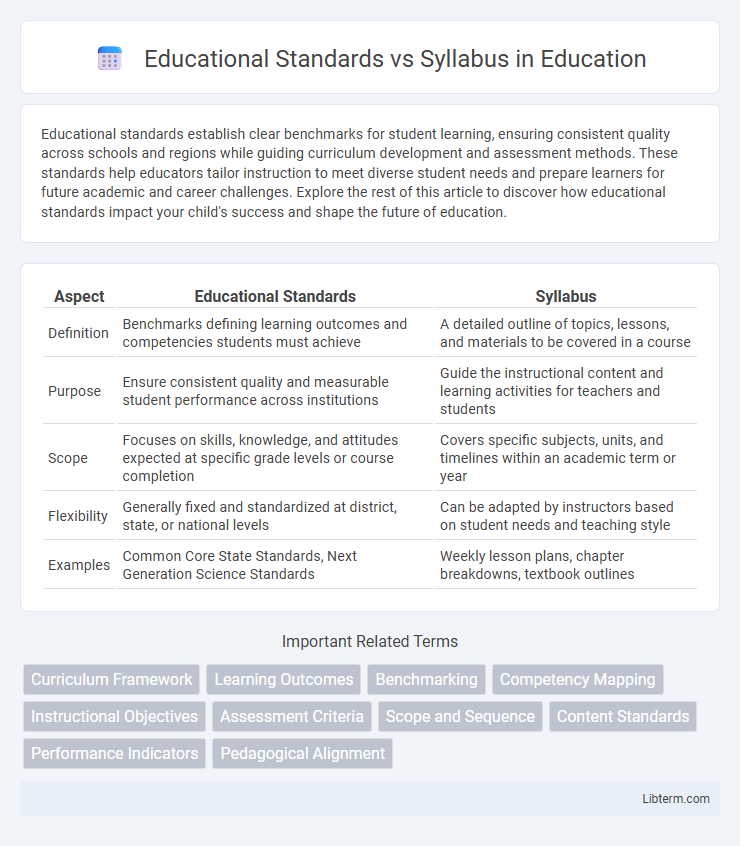Educational standards establish clear benchmarks for student learning, ensuring consistent quality across schools and regions while guiding curriculum development and assessment methods. These standards help educators tailor instruction to meet diverse student needs and prepare learners for future academic and career challenges. Explore the rest of this article to discover how educational standards impact your child's success and shape the future of education.
Table of Comparison
| Aspect | Educational Standards | Syllabus |
|---|---|---|
| Definition | Benchmarks defining learning outcomes and competencies students must achieve | A detailed outline of topics, lessons, and materials to be covered in a course |
| Purpose | Ensure consistent quality and measurable student performance across institutions | Guide the instructional content and learning activities for teachers and students |
| Scope | Focuses on skills, knowledge, and attitudes expected at specific grade levels or course completion | Covers specific subjects, units, and timelines within an academic term or year |
| Flexibility | Generally fixed and standardized at district, state, or national levels | Can be adapted by instructors based on student needs and teaching style |
| Examples | Common Core State Standards, Next Generation Science Standards | Weekly lesson plans, chapter breakdowns, textbook outlines |
Understanding Educational Standards and Syllabus
Educational standards define the learning goals and competencies that students are expected to achieve at each grade level, acting as benchmarks for academic performance across subjects. The syllabus outlines the specific content, topics, and materials that teachers use to deliver instruction aligned with these standards, ensuring a structured approach to curriculum delivery. Understanding the distinction between educational standards and the syllabus is key to designing effective lesson plans and assessments that meet both regulatory requirements and student learning needs.
Defining Educational Standards
Educational standards establish clear, measurable learning goals that define what students need to know and be able to do at various grade levels across subjects like math, science, and language arts. These standards provide a consistent framework for curriculum development, assessment design, and instructional quality to ensure equity in education nationwide. Unlike syllabi, which outline specific lesson plans and topics, educational standards set the overarching academic expectations that guide the creation of syllabi and educational materials.
What Is a Syllabus?
A syllabus is a detailed outline provided by educators that specifies the topics, objectives, assignments, and assessment methods for a particular course. It serves as a roadmap for students, highlighting the instructional content and learning activities planned throughout the academic term. Unlike educational standards, which define the broad skills and knowledge students must acquire, the syllabus translates these standards into concrete lessons and measurable outcomes for specific subjects.
Key Differences Between Standards and Syllabus
Educational standards define the learning goals and competencies students must achieve at each grade level, serving as benchmarks for academic performance across regions or states. A syllabus outlines the specific content, topics, assignments, and schedule a teacher follows to deliver instruction within a course, tailored to meet those broader standards. While standards establish what students should learn, the syllabus details how and when that learning will occur within the classroom setting.
The Role of Standards in Curriculum Design
Educational standards establish clear, measurable learning goals that guide curriculum development and ensure consistency across educational institutions. These standards serve as benchmarks for what students should know and be able to do at various grade levels, influencing the scope and sequence of the syllabus. By aligning the syllabus with educational standards, curriculum designers create structured, coherent learning experiences that promote academic achievement and skill mastery.
How Syllabus Translates Standards into Practice
Educational standards define the learning goals and skills students must achieve at each grade level, while the syllabus breaks down these standards into specific lessons, topics, and assessments tailored to the classroom context. By aligning the syllabus with established standards such as Common Core or Next Generation Science Standards (NGSS), educators translate broad educational objectives into actionable teaching plans and measurable outcomes. This structured approach ensures consistency in curriculum delivery and helps track student progress toward meeting state or national benchmarks.
Impact on Teaching and Learning Outcomes
Educational standards establish the learning goals and competencies students must achieve, providing a clear framework for curriculum development and assessment methods. The syllabus outlines the specific topics, materials, and schedule teachers follow to meet these standards, directly influencing instructional strategies and resource allocation. Aligning the syllabus with educational standards enhances teaching effectiveness and improves learning outcomes by ensuring consistency and coherence across educational programs.
Challenges in Aligning Standards with Syllabus
Aligning educational standards with the syllabus presents challenges such as gaps between prescribed learning outcomes and actual course content, leading to inconsistencies in student achievement. Curriculum developers often struggle to translate broad, abstract standards into specific, measurable syllabus objectives that cater to diverse learning needs. This misalignment can result in inadequate resource allocation and hinder effective assessment strategies, impacting overall educational quality.
International Perspectives on Standards and Syllabus
International perspectives on educational standards emphasize clear, measurable learning outcomes that define what students should know and be able to do at each grade level, enabling comparability across countries. Syllabi, however, are often tailored by individual institutions or regions, outlining specific content and instructional methods that may vary widely despite overarching standards. The alignment between international standards and local syllabi is crucial for ensuring consistency in education quality while allowing cultural and contextual flexibility.
Future Trends in Educational Standards and Syllabus Development
Future trends in educational standards emphasize adaptability, integrating digital literacy and personalized learning benchmarks to meet evolving workforce demands. Syllabus development increasingly incorporates interdisciplinary content and real-time data analytics to tailor curricula that foster critical thinking and global competencies. Emerging technologies and AI-driven insights will play a pivotal role in continuously updating educational frameworks for enhanced relevance and student engagement.
Educational Standards Infographic

 libterm.com
libterm.com